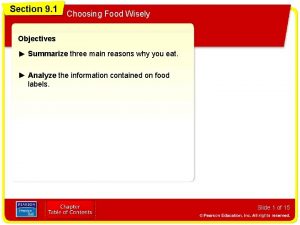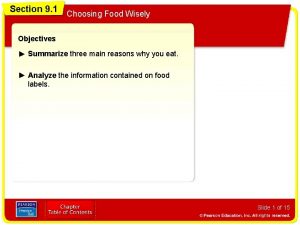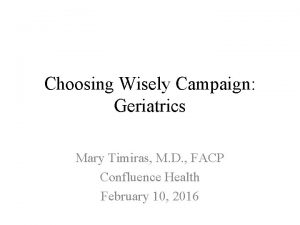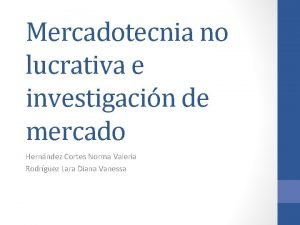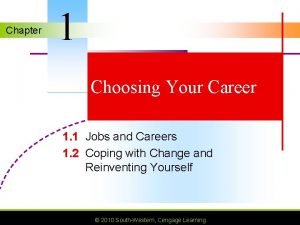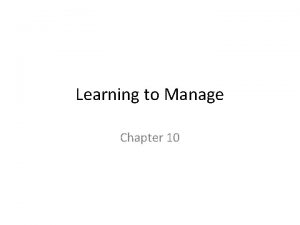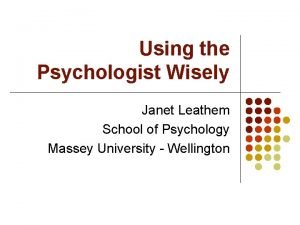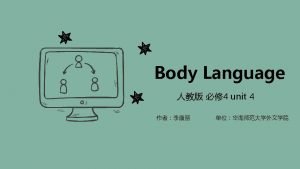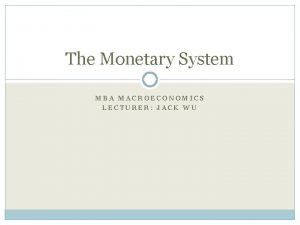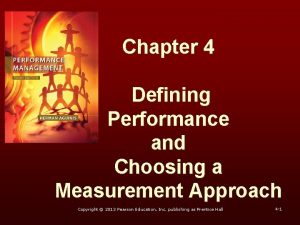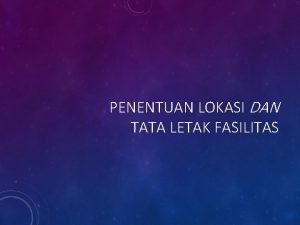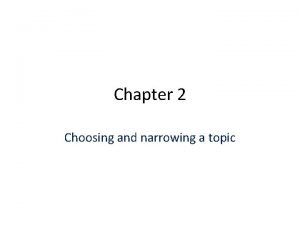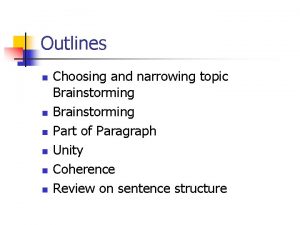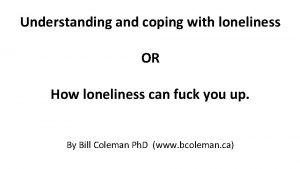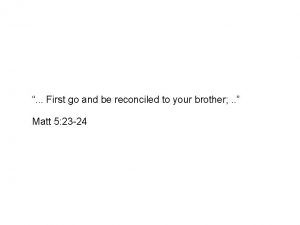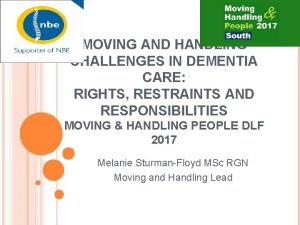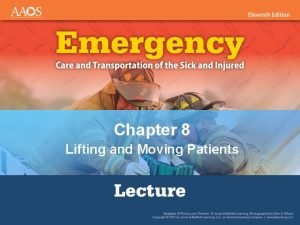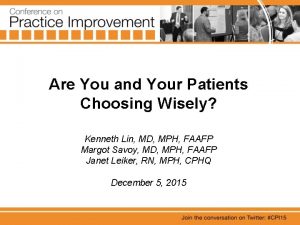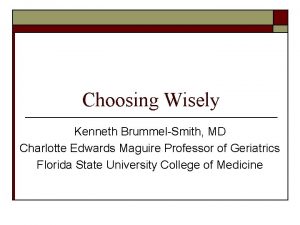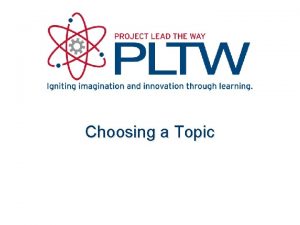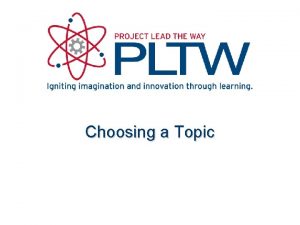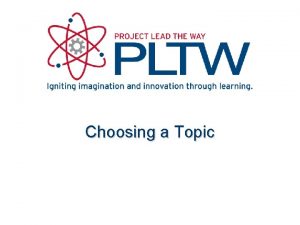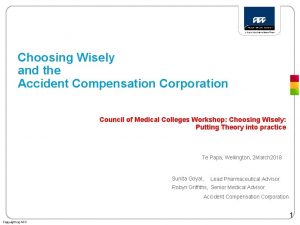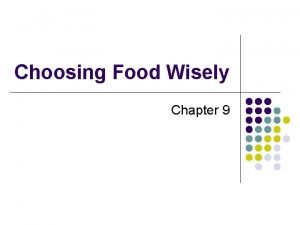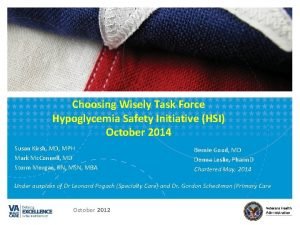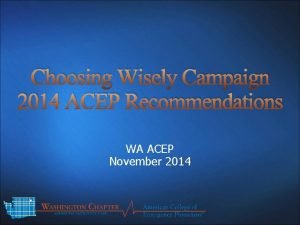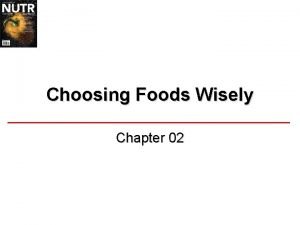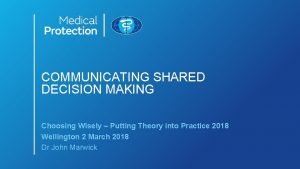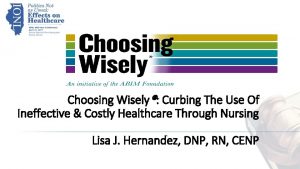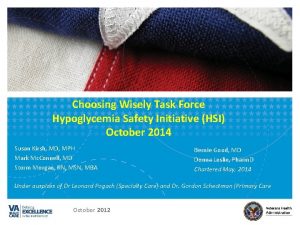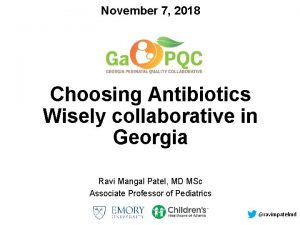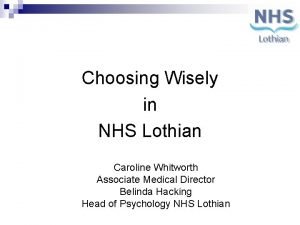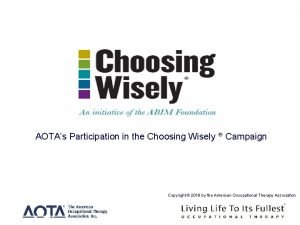Are You and Your Patients Choosing Wisely Kenneth



































- Slides: 35

Are You and Your Patients Choosing Wisely? Kenneth Lin, MD, MPH, FAAFP Margot Savoy, MD, MPH, FAAFP Janet Leiker, RN, MPH, CPHQ December 5, 2015

Disclosures All individuals in a position to control content for this activity have no relevant financial relationships to disclose.

Session Objectives • Participants should have learned the history and goals of the Choosing Wisely Initiative • Participants should be able to implement one or more Choosing Wisely recommendations in their practices • Participants should be able to demonstrate approaches to shared decision-making with patients about Choosing Wisely recommendations

How Choosing Wisely Came About • Estimated $150 -$200 billion in wasted health care spending in the U. S. annually • Medical overuse is defined as services that are unnecessary, likely to lead to more harms than benefits, or both • Waste and overuse are widespread and have effect on quality of care (up to 30, 000 deaths annually) *ABIM-F Advancing the Choosing Wisely Campaign in Clinical Practices and Communities

Choosing Wisely Background • Choosing Wisely was launched in 2012 by ABIM-F to help providers and patients engage in conversations to reduce the overuse of tests and procedures and to help patients make smart and effective care choices. • AAFP was one of the first medical specialty societies to participate, publishing our list of “Five Things Physicians and Patients Should Question, ” later expanded to include 15 tests and procedures to consider.

Choosing Wisely Participants • ABIM-F/Consumer Reports/ over 70 medical specialty societies – Non-physician organizations have also joined • Each society creates their own list of tests or treatments

AAFP Recommendations 1. Imaging for low back pain within first 6 weeks, unless red flags 2. Antibiotics for acute mild-to-moderate sinusitis, unless sx > 7 days or worsen 3. Dexa screening for osteoporosis- women < 65 or men < 70 with no risk factors 4. EKGs or other cardiac screening for low-risk patients without symptoms 5. Pap smears < 21 or had hysterectomy for non-cancer

AAFP Recommendations 6. Elective, non-medically indicated inductions of labor or Cesarean deliveries before 39 week, 0 days gestational age 7. Elective non-medically indicated inductions of labor between 39 weeks, 0 days and 41 weeks, 0 days 8. Screening for carotid artery stenosis in asymptomatic adult patients 9. Screening for cervical cancer > 65 if not high risk 10. Screening < 30 for cervical cancer with HPV testing

AAFP Recommendations 11. Antibiotics for otitis media in 2 -12 yr olds with non-severe symptoms where an observation option is reasonable 12. Voiding cystourethrogram routinely in first febrile UTI in children 2 -14 months 13. Routine screening for prostate cancer with PSA or digital rectal exam 14. Screening adolescents for scoliosis 15. Pelvic exam or other physical exam for oral contraceptives

How the Lists Were Made • First 5: Created by the National Physicians Alliance and published in the Archives of Internal Medicine as part of its “Less is More Series” • The list was reviewed by the Commission on Quality and Practice and the Commission on Health of the Public and Science and approved by the AAFP Board of Directors in 2012

Creation of Additional Choosing Wisely Recommendations • Second set of 5 recs: identified by the Commission on Health of the Public and Science in February 2013 • Third set of 5 recs: identified by the Commission on Health of the Public and Science in September 2013 • Criteria: items common in family medicine and supported by evidence to lead to significant health benefits, reduce risks, harms, and costs (Cochrane Reviews, AHRQ, USPSTF, AAP, ACOG, AAFP)

How AAFP Supports Choosing Wisely • AAFP leadership • Aligns with AAFP Strategic Objectives. Health of the Public and Science • Commission on Health of the Public and Science oversees Choosing Wisely • Commission is focused on implementation vs. adding more recommendations at this time

AAFP’s Promotion of Choosing Wisely • Worked with Consumer Reports to develop patientfriendly versions for 7 of the recommendations • Consumer Reports and Drexel University created videos on key communication concepts for 3 recommendations http: //www. aafp. org/news/inside-aafp/20131007 choosingwiselyvideos. html • CW recs included in applicable CME courses • Chapter Involvement • Overview of Choosing Wisely video, Michael Le. Fevre MD, MSPH http: //www. aafp. org/choosing-wisely/modules/m_02/content/0_1_Welcome. htm

AAFP’s Promotion of Choosing Wisely (cont. ) • • • Electronic newsletters Website Content & Promotions AFP Online PC CW Database AAFP Presidential leadership & support On-going presentations at FMX, National Conf, ALF, CPI (very popular and rated highly) Internal Staff CW Team works with CHPS Future ABIM-F Choosing Wisely Champion Program Renewed agreement with Consumer Reports for more patient materials Patient handouts familydoctor. org New agreement with EPIC to incorporate AAFP recs in EHR



Choosing Wisely’s Reach • Increasing physician and public awareness – ABIM-F 2014 Survey: • 20% of physicians were aware of Choosing Wisely • 5% of the general public *ABIM-F Advancing the Choosing Wisely Campaign in Clinical Practices and Communities

ABIM-F Choosing Wisely Survey • 73% of physicians say the frequency of unnecessary tests and procedures is a very or somewhat serious problem. • 53% of physicians say that even if they know a medical test is unnecessary, they order it if a patient insists. • 72% of physicians say the average medical doctor prescribes an unnecessary test or procedure at least once a week. • 47% of physicians say their patients ask for an unnecessary test or procedure at least once a week. • 70% of physicians say that after they speak with a patient about why a test or procedure is unnecessary, the patient often avoids it. Source: http: //www. choosingwisely. org/about-us/research-report/

ABIM-F Survey: Implementation Challenges • Fear that the goal is to save money for payers rather than improve care • Dispute of the scientific basis of the recommendations • Negative perception of the “Don’t do” wording • Public needs to understand more about the campaign • Malpractice needs to be addressed before making a change

Take Aways from ABIM-F Survey • Problem of overuse tends to center on malpractice concerns and physician’s desire to reassure themselves • They need specific evidence-based recs around unnecessary care to use with patients • Those exposed to CW significantly more likely to have reduced amount of unnecessary care in past year

AAFP Member Survey Sept 2015 • N= 273 members (41% response rate from 672 volunteers in “Member Insight Exchange”) • 73% were somewhat or very familiar with Choosing Wisely • AAFP was most common resource for obtaining knowledge (96% found website valuable) • 65% implemented at least “some” of the recs

AAFP Member Survey Sept 2015 • Most common CW recs implemented: – Low back pain; Pelvic exam for OC; Screening for cervical cancer >65; Pap smears • Tools most often used: – 35%: AAFP CW web pages – 26%: EHR reminders – 17%: Patient handouts

AAFP Member Survey Sept 2015 Most Common Barriers Reported: – 61% Patient resistance – 42% Lack of time – 6. 6% Lack of confidence in the evidence behind the recommendation – 3. 4% Lack of interest – 12. 4% Other (hard to break habits, lack of awareness of CW, remembering them, cooperation with other physicians, other specialists don’t follow it and are incentivized to cont. , time constraint with integration into EHRs)

2015 FMX Choosing Wisely Sessions • 2 Sessions • Based on Session, I will: #1 – Pursue additional educ/reading – Discuss with colleagues/obtain consensus about a practice change – Continue current practice – Implement a change in practice from what I learned in the session #2 28%; 26% 22%; 23% 19%; 20% 31%; 32% (N# 1= 186) (N# 2= 203)

FMX Session Attendees’ Plans • “Will get our practice to pick a few Choosing Wisely issues for us” • “Less back imaging and pap tests” • “Will present at our Journal Club” • “Will use motivational interviewing to address unnecessary testing” • “Discuss with hospitalist partners to identify areas for improvement” • “Propose offering a local CME presentation at my hospital” • “Place posters in the waiting room stating doctors may be limiting some tests in accordance with most recent findings”

FMX Session Member Comments • “I wish I could convince some of my colleagues that over-utilize this stuff” • “Guidelines are almost always based on old evidence” • Physicians must always retain the autonomy and ability to use their own knowledge, experience, current evidence, and the patient’s unique history and exam. ” • “A good concept: Waste can cause harm. ”

It Takes Two. Engaging Consumers • Research from Consumer Reports found that most patients are responsive to messages about overuse that emphasize safety and risk – Make it about avoiding unneeded and potentially harmful test & treatments that offer no benefit • Use decision aids with information about alternatives patient can embrace

Choosing Wisely- Current State • Nearly 400 recommendations for overused or unnecessary tests, treatments or procedures • Nearly 100 patient-friendly brochures created by Consumer Reports and specialty societies • >274 journal articles published • International adoption by 11 countries, including Australia, Canada, Italy and New Zealand • Implementation by health systems across the country • Nearly 2 ½ million visits to www. choosingwisely. org • Nearly 14, 000 U. S. media mentions

Findings on Early Impact from Choosing Wisely Initiative “Early Trends Among Seven Recommendations From the Choosing Wisely Campaign” – JAMA Intern Med. Doi: 10. 1001/jamainternmed. 2015. 5441

Case Scenario # 1 – A child with otitis media • Healthy 2 year-old boy with low-grade fever, URI symptoms, right ear pain • Exam: redness + bulging of right TM with immobility on insufflation • Appears alert and well hydrated • You recommend acetaminophen and 48 to 72 hours of observation • Parent requests an antibiotic

Case Scenario # 2 – A man requests PSA testing • 55 y/o man with BMI of 28, no family history of cancer in for well-male exam • Denies symptoms, unremarkable history and physical examination • Mentions that a 60 y/o co-worker was recently diagnosed with prostate cancer • “You’re going to order the PSA test, aren’t you, doc? ”

How Can AAFP Help You?

Summary and Questions

Resources Find information, lists of recommendations and patient resources at: www. choosingwisely. org www. abimfoundation. org/Initiatives/Choosing. Wisely. aspx www. aafp. org/about/initiatives/choosing-wisely. html www. aafp. org/afp/recommendations/search. htm http: //www. choosingwisely. org/clinician-lists http: //www. aafp. org/journals/fpm. html

Please evaluate this presentation using the conference mobile app! Simply click on the "clipboard" icon on the presentation page.
 Choosing food wisely quiz
Choosing food wisely quiz Choosing food wisely
Choosing food wisely Choosing wisely geriatrics
Choosing wisely geriatrics Antigentest åre
Antigentest åre Lucrativae
Lucrativae Free vs blank verse
Free vs blank verse You put your left foot in
You put your left foot in Chapter 1 choosing your career
Chapter 1 choosing your career Chapter 11 section 4 using water wisely answer key
Chapter 11 section 4 using water wisely answer key Chapter 11 section 4 using water wisely answer key
Chapter 11 section 4 using water wisely answer key It is a practice of using resources wisely
It is a practice of using resources wisely Wisely using resources to achieve goals is known as
Wisely using resources to achieve goals is known as 4.3 using studies wisely
4.3 using studies wisely Janet leathem
Janet leathem As i walk this wicked world
As i walk this wicked world Wisely definition
Wisely definition You say you love rain
You say you love rain Before choosing a position or side, you should
Before choosing a position or side, you should Give us your hungry your tired your poor
Give us your hungry your tired your poor You are good and your love endures forever
You are good and your love endures forever Hapi nod
Hapi nod You take $100 you had kept
You take $100 you had kept 3 approaches to measuring performance
3 approaches to measuring performance Defining performance and choosing a measurement approach
Defining performance and choosing a measurement approach Perencanaan lokasi perusahaan
Perencanaan lokasi perusahaan Choosing and narrowing a topic
Choosing and narrowing a topic Choosing and narrowing a topic
Choosing and narrowing a topic Accept your loneliness you are your only friend
Accept your loneliness you are your only friend Be reconciled to your brother
Be reconciled to your brother Maintaining a healthy body composition and body image quiz
Maintaining a healthy body composition and body image quiz Please clean your room
Please clean your room Sore breasts before period
Sore breasts before period Tell me what you eat and i shall tell you what you are
Tell me what you eat and i shall tell you what you are 10 principles of lifting when moving a patient
10 principles of lifting when moving a patient Moving and handling dementia patients
Moving and handling dementia patients When performing the rapid extrication technique
When performing the rapid extrication technique
